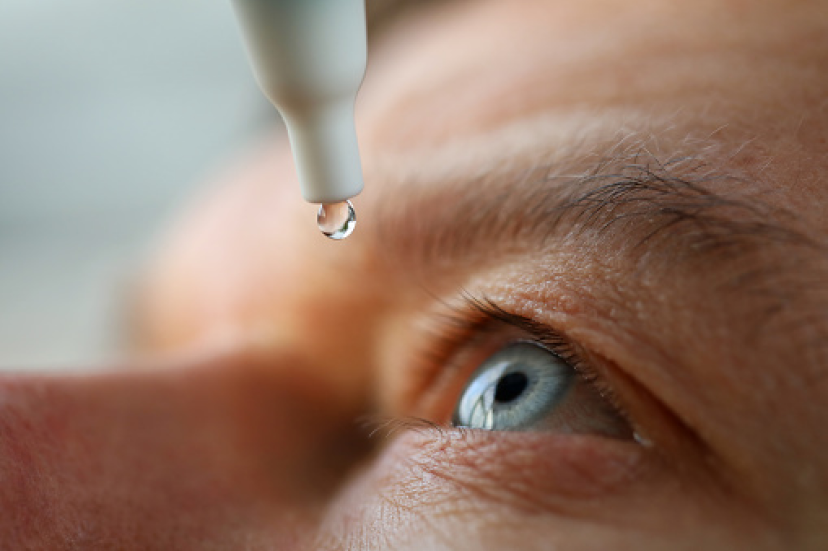What Are Dry Eyes
The eyes need tears to keep the cornea (front of the eye) lubricated and comfortable. Dry eyes occur when the eyes do not produce enough tears or don’t produce the right type of tears.
The delicate tear film acts as a protective covering on the eye and is made of three layers. The outer layer is oily and reduces evaporation of the tears. The middle layer is watery and cleanses the eye as in crying. The inner layer is made of mucus and allows the tears to stay on the surface of the eye.
Watery tears flow into the eye from the glands located above the eye. These tears are released during injury and emotion. Lubricating tears produce the tear film, which originates in the glands located in the eyelids. This film is spread over the eye by blinking. Tears are also effective at reducing infections because they contain an antibacterial substance

How are dry eyes diagnosed?
During the eye exam, Dr. Waters will be able to check the health of the cornea and tear film layers to determine if there are signs of dry eyes. There are times when he is able to see dry eyes and the patient isn’t experiencing any symptoms. This is why regular eye exams are important. Patient cannot achieve their best vision when the eyes are dry.

From Our Blog:
Do You Suffer from Dry Eyes?
There are two questions Dr. Waters always asks patients during his exam. The first is “How’s your vision?” and the second is “How do your eyes feel?” This second question is equally important because sometimes eyes feel itchy, scratchy, dry, tired or heavy.
What causes dry eyes?
- Age
- Long-term contact lens wear
- Environmental pollution and irritants
- Some forms of medication
- Sun and wind
- Lack of humidity
- Smoke
- Poor eyelid function
- Some diseases like Rheumatoid Arthritis, Sjögren’s, Thyroid, and Lupus
Symptoms of dry eyes
- Blurry vision
- Stinging, burning feeling
- Scratchy or gritty feeling
- Redness and irritation
- Painful, especially when wearing contact lenses
- Excess tearing*
- Sensitivity to light
*People with dry eyes will often complain of excess tearing and watery eyes, which may seem like the opposite of dry eyes. However, in response to the irritation from dry eyes, reflex tears (as in crying) are produced. These reflex tears are not helpful to lubrication, however, because they are the watery tears, not the oily lubricating tears.
What Is The Treatment For Dry Eyes?
- Preservative-Free Artificial tears. These tears replace the moisture and are used as necessary throughout the day. It is important to use preservative-free artificial tears that come in individual vials. Bottled tears with preservatives can irritate the eye with continuous use.
- Refresh pm. This is an ointment that can be placed in the lower eyelids at bedtime, which increases comfort.
- Omega 3 vitamins. Omega 3 vitamins, such as Thera Tears Nutrition, also work with the anatomy of the eye to create more productive tears. Long term use of this vitamin is recommended for dry eyes.
- Restasis or Xiidra. These are prescription drops that can be used if over-the-counter drops aren’t effective by themselves.
- Humidifier. Patients should use a humidifier whenever the furnace is turned on.
- Punctal Plugs. These are very tiny soft plugs placed in the punctum (or tear duct) to block tear drainage and help keep productive tears on the surface of the eye.
Dennis J.

I saw Brenda and Dr. Waters this week for the first time. Color me impressed. They were friendly, efficient, patient and thorough. There was no upsell, just a complete exam and a warm welcome.
Patti P.

Appointment today regarding miserable dry eye symptoms I've been dealing with for years, walked our with a schedule of what to use, and what not to use. Making the appointment was professional, informational and friendly. That was the the same and more with my testing with Tammi and Dr Waters' exam. I could tell my treatment as a patient is how the employees are treated. Highly recommended to me, and I now will do the same!
Edward V.

Doctor Waters and his staff are absolutely the best! Dr. Waters was able to help me with a rare eye condition when other ophthalmologist wouldn’t even touch my eye. Recently, Dr Waters performed cataract surgery on my right eye and when they checked me the very next day I had better than perfect vision I had 20/15 and perfect 20/20 reading with the symphony lens. Before surgery my distance vision was 20/100 and reading was 20/80. Surgery was a breeze! Believe me when I tell you Dr. Waters is very skilled and keeps updated with the latest technology at his practice. I strongly recommend Dr. Waters he is kind, knowledgeable, skilled, and gentle!

Meet Your Doctor
John A. Waters, M.D., established Complete Eye Care on the premise that he would dramatically improve the patient-physician relationship and create a more personalized form of healthcare. He has devoted his career to patient advocacy in the insurance maze and has sought to educate patients not only about their health but on their healthcare choices. In addition, he has ensured that he and his staff are trained in the best cultural competence and health literacy practices in order to tailor eye care to meet individual patient needs.
Let Us Help!
We are here to help! To make an appointment simply fill out this form and someone will contact you shortly to find a day and time that works well for your schedule.
Rather Talk To Someone Now?
You can call us at 810-732-2272 8 a.m. to 5 p.m. Monday through Thursday.
